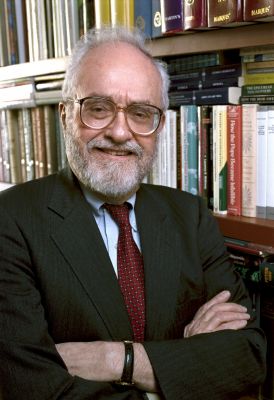March 2017

Mathematician Felix Browder led a storied life that included a Ph.D. at age 20, McCarthy-era career setbacks, the National Medal of Science in 2000, and over thirty years on the Rutgers faculty. Browder’s personal history is remembered in memorials in the New Yorker and the Washington Post, while some of his contributions to the field of mathematics are highlighted in his 1997 nomination for president of the American Mathematical Society (AMS).
The Washington Post memorial notes Browder’s role in “establishing a science and technology center in conjunction with Princeton and Bell Labs,” and the AMS nomination similarly noted that he “initiated the successful Science and Technology Center that involved Bell Labs, Rutgers, and Princeton University”. That center, of course, was DIMACS.
In a February memorial for Browder at Rutgers, Fred Roberts, Director Emeritus of DIMACS, was asked to reflect on Browder’s role in forming DIMACS. Later, he prepared a more detailed account for inclusion in a future remembrance of Browder in Notices of the AMS.
With the passage of time, historical connections are easily forgotten, so in recognition of Felix Browder’s vision for a NJ center dedicated to discrete mathematics and theoretical computer science, we share Roberts’s recollection in its entirety.
Some reflections on Felix Browder and the formation of DIMACS by Fred Roberts:
Not many people realize the critical role that Felix Browder played in the formation of DIMACS.
Felix came to Rutgers as Vice President for Research in 1986 and one of his early initiatives was to spearhead the Rutgers proposal for a National Science Foundation Science and Technology Center (STC). The STC program had three major components: cutting edge science in some field, education closely tied to research, and technology transfer. It required university, industry, and government partners.
When the STC program was announced, Rutgers, Princeton, and what were then AT&T Bell Labs and Bellcore (Bell Communications Research) all had strong programs in discrete mathematics and theoretical computer science, but they were only interacting sporadically and informally. Felix had the insight to see that a “NJ Center for Discrete Mathematics and Theoretical Computer Science” already existed in some sense. Felix managed to get Danny Gorenstein of Rutgers involved and to agree to serve as Director (a critical development). They were joined by Ron Graham of Bell Labs and later Bob Tarjan of Princeton. Felix also played an important role in getting the NJ Commission on Science and Technology to join the team as the government partner.
The Rutgers-led proposal was a winner in the first-ever STC competition—one of 11 winners in all fields of science—leading to the formation of DIMACS, The Center for Discrete Mathematics and Theoretical Computer Science, in early 1989. It is fair to say that we would not have gotten started on this without Felix. He played a pivotal role.
When Rutgers received the NSF award for DIMACS, it was at the time the largest award the university had ever gotten (some $22M) and a major center kickoff conference was held, with NJ Governor Tom Kean giving a keynote address. In character, Felix was there, but stayed in the background. He didn’t need the public thanks that many of us who have benefited from DIMACS owe him.
Felix continued to play an important role as DIMACS grew and developed. He also found it useful to leverage the existence of DIMACS to recruit Israel Gelfand to Rutgers, arranging for DIMACS to provide both space and resources for Gelfand’s many visitors. The scientific and educational collaboration between DIMACS and Gelfand continued until his death and indeed continues today through the work of Tanya Gelfand to get her late husband’s educational books published. This too is part of the legacy of Felix Browder.
Felix continued to be interested in DIMACS long after he stepped down as VPR at Rutgers. He often asked how things were going, and even when he could no longer come to the office, looked for opportunities for the center and the university to benefit. One of the last times I saw him was when he became aware of the Simons Foundation announcement for a $60M Institute for the Theory of Computation and invited me to strategize about how DIMACS could apply. I visited him at home, and we had a wide-ranging discussion. While our proposal didn’t win (UC Berkeley’s did), it was still another reminder of how Felix remained engaged with, interested in, and committed to both Rutgers University and the center he played such a great role in founding.
Reference:
Jerry Bona, “Nomination for Felix Browder,” Notices of the AMS 44(8), 954-955, September, 1997.
Photo credit: Nick Romanenko


